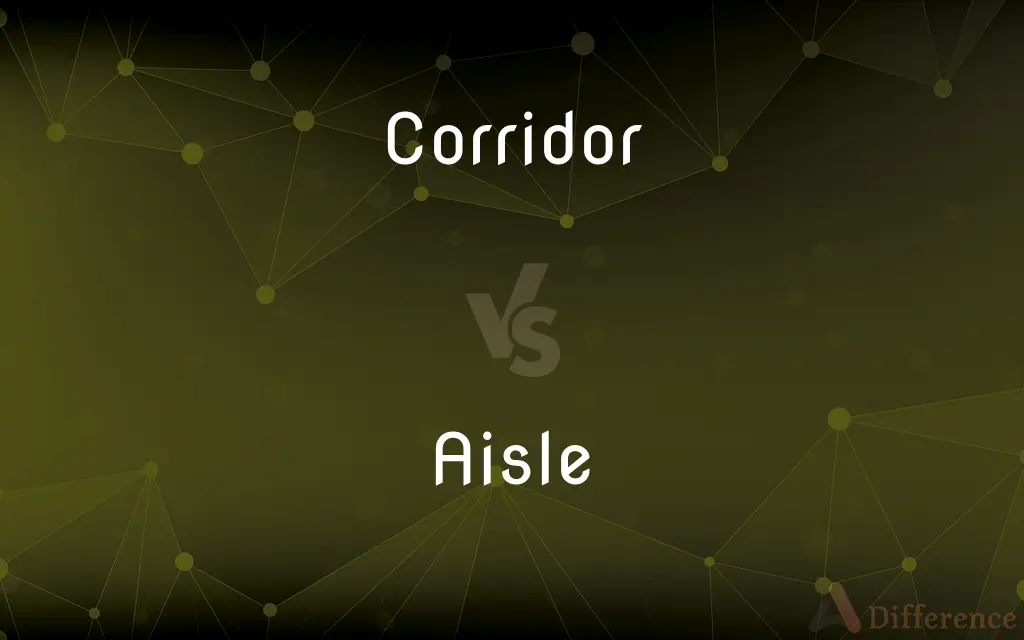Corridor vs. Aisle — What's the Difference?
By Tayyaba Rehman & Urooj Arif — Updated on April 3, 2024
A corridor is a long passage in a building or train, while an aisle is a space for walking between rows, as in supermarkets or airplanes.

Difference Between Corridor and Aisle
Table of Contents
ADVERTISEMENT
Key Differences
Corridors are architectural features found in buildings, ships, or trains, characterized by their elongated passageways that connect rooms or compartments. They are integral to the structure's layout, facilitating movement and access throughout the space. Aisles, on the other hand, refer to the spaces between rows of seats, shelves, or other objects, providing a pathway for people to move or access various points along the rows. While both serve as pathways, their contexts and functions distinguish them significantly.
Corridors often act as the main arteries of a building, guiding traffic flow and providing access to different areas within the structure. They can be found in residential, commercial, and industrial buildings, serving both functional and aesthetic purposes. Aisles, however, are typically found within specific rooms or areas, such as theaters, supermarkets, or churches, and are designed to optimize access and organization within those spaces.
The design and width of corridors are influenced by architectural considerations, including building codes and intended use, ensuring safe and efficient movement. Aisles, in contrast, are shaped by the layout of the objects they flank, such as seats or shelves, and their width can vary significantly based on the venue's capacity and the expected flow of people.
In terms of navigation, corridors may have signage or other indicators to help orient and direct people to their destinations within a building. Aisles might also have signage, especially in large stores or venues, but their primary function is to facilitate access to items or seating, rather than to guide people to various parts of a building.
While both corridors and aisles are pathways that allow movement, their presence and purpose in a space highlight the differences in their roles and design considerations. Corridors are structural elements that contribute to the overall layout and functionality of a building, whereas aisles are components of interior spaces, designed to enhance accessibility and organization within those areas.
ADVERTISEMENT
Comparison Chart
Definition
A long passageway in a building or vehicle.
A space for walking between rows of seats or shelves.
Location
Connects rooms or compartments within a structure.
Found within rooms or areas, between rows.
Function
Facilitates movement and access throughout a space.
Optimizes access and organization within a space.
Design Influences
Architectural considerations and building codes.
Layout of flanking objects like seats or shelves.
Context
Residential, commercial, industrial buildings, vehicles.
Theaters, supermarkets, churches, airplanes.
Compare with Definitions
Corridor
Often associated with institutional or residential buildings.
The school's corridors were adorned with students' art.
Aisle
Utilized for access and organization in various venues.
The conference set up aisles for easy movement between booths.
Corridor
Reflects the architectural style and functionality of a building.
The glass-walled corridor offered views of the garden.
Aisle
Influences the layout and flow of movement in a space.
Wider aisles accommodate more shoppers during peak hours.
Corridor
A long, narrow passageway in a building connecting various rooms.
The hotel's corridor led to a series of guest rooms.
Aisle
A walkway between rows of seats in a theater or vehicle.
He found his seat halfway down the aisle.
Corridor
Used in transportation, like trains or ships, to connect compartments.
She walked through the train's corridor to reach the dining car.
Aisle
The space between shelves in stores, like supermarkets.
The cereal is located in aisle 4.
Corridor
Can serve as emergency evacuation routes.
Emergency lights illuminated the corridor during the drill.
Aisle
Can be designed for specific purposes, like wedding aisles.
Flowers lined the wedding aisle.
Corridor
A long passage in a building from which doors lead into rooms
His room lay at the very end of the corridor
Aisle
An aisle is, in general, a space for walking with rows of seats on both sides or with rows of seats on one side and a wall on the other. Aisles can be seen in airplanes, certain types of buildings, such as churches, cathedrals, synagogues, meeting halls, parliaments and legislatures, courtrooms, theatres, and in certain types of passenger vehicles.
Corridor
A narrow hallway, passageway, or gallery, often with rooms or apartments opening onto it.
Aisle
A passage between rows of seats in a building such as a church or theatre, an aircraft, or train
The musical had the audience dancing in the aisles
Corridor
A tract of land designated or used for a specific purpose, as for railroad lines, highways, or pipelines.
Aisle
A part of a church divided laterally from the nave, transept, or choir by a row of columns.
Corridor
A route designated for a specific purpose
A hazardous material corridor.
A sea corridor for shipping.
A flight corridor.
Aisle
A passageway between rows of seats, as in an auditorium or an airplane.
Corridor
A route or tract of land used by migrating animals.
Aisle
A passageway for inside traffic, as in a department store, warehouse, or supermarket.
Corridor
A thickly populated strip of land connecting two or more urban areas
People who live in the Boston-Washington corridor.
Aisle
A wing of a building, notably in a church separated from the nave proper by piers.
Corridor
A narrow hall or passage with rooms leading off it, as in a building or in a railway carriage.
Aisle
A clear path through rows of seating.
Corridor
A restricted tract of land that allows passage between two places.
Aisle
A clear corridor in a supermarket with shelves on both sides containing goods for sale.
Corridor
The covered way lying round the whole compass of the fortifications of a place.
Aisle
Any path through an otherwise obstructed space.
Corridor
Airspace restricted for the passage of aircraft.
Aisle
(transport) Seat in public transport, such as a plane, train or bus, that's beside the aisle.
Corridor
A gallery or passageway leading to several apartments of a house.
Aisle
An idiomatic divide between the Republican Party and the Democratic Party, who are said to be on two sides of the aisle.
Corridor
The covered way lying round the whole compass of the fortifications of a place.
Aisle
The path of a wedding procession in a church or other venue; marriage.
Corridor
Any relatively narrow passageway or route, such as a strip of land through a foreign territory.
Aisle
A lateral division of a building, separated from the middle part, called the nave, by a row of columns or piers, which support the roof or an upper wall containing windows, called the clearstory wall.
Corridor
A densely populated stretch of land; as, the Northeast corridor, extending from Richmond, Virginia into Maine.
Aisle
A long narrow passage (as in a cave or woods)
Corridor
An enclosed passageway; rooms usually open onto it
Aisle
Passageway between seating areas as in an auditorium or passenger vehicle or between areas of shelves of goods as in stores
Aisle
Part of a church divided laterally from the nave proper by rows of pillars or columns
Common Curiosities
What is the main purpose of an aisle?
The main purpose of an aisle is to provide a pathway for people to access and navigate between rows of seats, shelves, or other objects.
What is a corridor?
A corridor is a long, narrow passageway within a building or vehicle that connects different rooms or compartments.
Are corridors considered architectural elements?
Yes, corridors are integral architectural elements that contribute to the layout and functionality of a building.
How does an aisle differ from a corridor?
An aisle is a space for walking between rows of seats or shelves, specifically designed for access within a room or area, unlike a corridor, which serves as a main passageway in a building.
Can corridors be found outside of buildings?
Yes, corridors can also refer to passages in vehicles like trains and ships, connecting different compartments.
Do corridors have to be straight?
No, corridors can be straight, curved, or angular, depending on the building's design and functional requirements.
Why are aisles important in supermarkets?
Aisles in supermarkets are crucial for organizing products and facilitating the flow of customers, making shopping more efficient.
How do aisles enhance a space?
Aisles enhance a space by optimizing access and organization, making it easier for people to move and find what they need.
Can a corridor be a feature in landscape design?
In landscape design, pathways or walkways connecting different areas can be considered corridors, although the term is less commonly used in this context.
Can aisles be temporary?
Yes, aisles can be temporary, especially in event venues or outdoor settings where they are set up for specific occasions.
What influences the width of a corridor?
The width of a corridor is influenced by architectural considerations, building codes, and the intended use of the space.
What role do aisles play in emergency evacuations?
Aisles play a crucial role in emergency evacuations, providing clear and accessible paths to exits, especially in crowded or compact spaces.
How do design considerations for aisles and corridors differ?
Design considerations for aisles focus on the layout of adjacent rows and customer or user experience, whereas corridors are designed with broader architectural and safety standards in mind.
Are there regulations affecting corridor design?
Yes, there are building codes and safety regulations that dictate aspects of corridor design, including width, lighting, and evacuation routes.
How does the function of a corridor reflect on its maintenance?
Maintenance of corridors is important for safety, accessibility, and aesthetic reasons, reflecting their continuous use and role in connecting different parts of a building.
Share Your Discovery

Previous Comparison
Lethargic vs. Obtunded
Next Comparison
Slogan vs. MantraAuthor Spotlight
Written by
Tayyaba RehmanTayyaba Rehman is a distinguished writer, currently serving as a primary contributor to askdifference.com. As a researcher in semantics and etymology, Tayyaba's passion for the complexity of languages and their distinctions has found a perfect home on the platform. Tayyaba delves into the intricacies of language, distinguishing between commonly confused words and phrases, thereby providing clarity for readers worldwide.
Co-written by
Urooj ArifUrooj is a skilled content writer at Ask Difference, known for her exceptional ability to simplify complex topics into engaging and informative content. With a passion for research and a flair for clear, concise writing, she consistently delivers articles that resonate with our diverse audience.













































